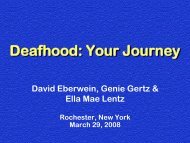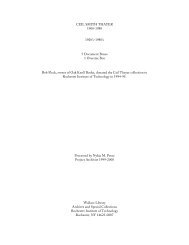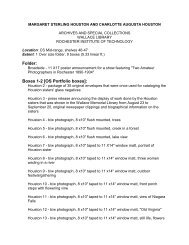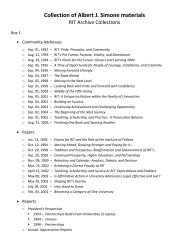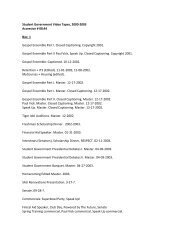The Light of the Sublime - RIT Libraries - Rochester Institute of ...
The Light of the Sublime - RIT Libraries - Rochester Institute of ...
The Light of the Sublime - RIT Libraries - Rochester Institute of ...
Create successful ePaper yourself
Turn your PDF publications into a flip-book with our unique Google optimized e-Paper software.
Th e Works <strong>of</strong> rum i<br />
as i nTe rpreTe d by Zah ra parTovi<br />
an d vi nc e nT fiTZ G e rald & co.<br />
riT cary G raph ic arTs collecTion<br />
ro c h e sTe r, ny<br />
201 2
<strong>The</strong> drawings reproduced in this catalogue are by don kunz<br />
from <strong>The</strong> Parrot & <strong>the</strong> Merchant, 1981, <strong>the</strong> first rumi book published<br />
by vincent fitzGerald & co. (see page 21).<br />
Translations & “a poet’s voice” ©2012 Zahra partovi<br />
catalogue & introduction ©2012 riT cary Graphic arts collection<br />
all rights reserved.<br />
www.vincentfitzgerald.com<br />
cary.rit.edu
conTe nTs<br />
introduction<br />
by amelia hugill-fontanel 6<br />
Jalaluddin mohammad rumi,<br />
life and Works 8<br />
a poet’s voice<br />
by Zahra partovi 10<br />
selections from <strong>The</strong> Masnavi,<br />
translated by Zahra partovi 13<br />
<strong>The</strong> poetry <strong>of</strong> rumi in Translation by Zahra partovi<br />
published by vincent fitzGerald & co.,<br />
1981–2012 21<br />
collaborating artists & artisans 26<br />
selected institutional collections<br />
with vincent fitzGerald & co. books 28<br />
5
i nTroducTion<br />
6<br />
One who is pure is drowned in <strong>the</strong> light <strong>of</strong> <strong>the</strong> <strong>Sublime</strong><br />
He is <strong>the</strong> son <strong>of</strong> no one, free from time and states <strong>of</strong> feeling<br />
Letters by rumi; translated by Zahra partovi, 1986<br />
Deep veneration or uplifting emotion can be inspired by<br />
that which is truly sublime – something or some idea that is<br />
beautiful, magnificent, or pr<strong>of</strong>ound. light from <strong>the</strong> natural<br />
world, or even from one’s inner eye, plays a part in reveal-<br />
ing or obscuring this greatness. it is precisely this dance<br />
<strong>of</strong> revelation that Jalaluddin mohammad rumi sought to<br />
elucidate in his prolific poetry. his words have transcended<br />
<strong>the</strong> passage <strong>of</strong> seven centuries and continue to be as rel-<br />
evant as when first written, no doubt because he covered<br />
universal human concepts including art, love, travel, self-<br />
lessness, and spirituality. metaphors about <strong>the</strong> power <strong>of</strong><br />
light are woven throughout rumi’s verse, and are a<br />
common thread in <strong>the</strong> series <strong>of</strong> interpretive livres d’artistes<br />
created from translations <strong>of</strong> rumi by Zahra partovi,<br />
published by vincent fitzGerald & co.<br />
Translation is vital to creating relationships between<br />
cultures. over decades <strong>of</strong> translating <strong>the</strong> works <strong>of</strong> rumi,<br />
Zahra partovi acts as a skillful medium through which<br />
rumi’s poetry in medieval persian is transformed into <strong>the</strong><br />
vernacular <strong>of</strong> contemporary english. her resulting translations<br />
are <strong>the</strong> basis <strong>of</strong> fifteen books published in new york –<br />
evidence that culture can be bridged through words. but<br />
words alone do not mark <strong>the</strong>se books: vibrant imagery,<br />
innovative form, and quality craftsmanship are <strong>the</strong> signatures<br />
<strong>of</strong> vincent fitzGerald & co. books.
<strong>The</strong> visual and physical translation <strong>of</strong> <strong>the</strong> rumi livres<br />
d’artistes is as essential as <strong>the</strong> text translation. vincent<br />
fitzGerald commissions fine artists to interpret texts, and<br />
guides <strong>the</strong>ir creative output into a limited-edition print-<br />
making or sometimes-sculptural process that is presented<br />
in book form. <strong>The</strong> illustrative prints are truly “multiple<br />
originals,” made with myriad techniques including engraving,<br />
etching, screen printing, lithography, and photogravure.<br />
collaboration with artisans is key to syn<strong>the</strong>size <strong>the</strong> final<br />
works, which incorporate calligraphy, exquisite typography,<br />
letterpress printing on custom-made paper, and hand<br />
binding. fitzGerald’s most recent publications use surprising<br />
substrates: carbon steel, laser-etched glass or lucite,<br />
and even projected light. <strong>The</strong> combined orchestrated effort<br />
<strong>of</strong> <strong>the</strong>se books approaches <strong>the</strong> sublime at <strong>the</strong> pinnacle <strong>of</strong><br />
<strong>the</strong> bookmaking art.<br />
<strong>The</strong> cary Graphic arts collection is pleased to celebrate<br />
this fusion <strong>of</strong> text, art, and craft in <strong>the</strong> rumi series with our<br />
exhibition, “<strong>The</strong> light <strong>of</strong> <strong>the</strong> sublime.” our library comprehensively<br />
collects <strong>the</strong> works <strong>of</strong> vincent fitzGerald & co.<br />
as exemplars <strong>of</strong> <strong>the</strong> book arts genre, meant to inspire our<br />
community with <strong>the</strong>ir beauty, magnificence, and depth. We<br />
hope that <strong>the</strong> works that we have assembled demonstrate<br />
both <strong>the</strong> sublimity <strong>of</strong> <strong>the</strong> book arts in its evolving form<br />
and <strong>the</strong> timelessness <strong>of</strong> rumi’s poetry.<br />
Amelia Hugill-Fontanel<br />
riT cary Graphic arts collection<br />
7
Jalalu ddi n moham mad rum i<br />
li fe an d Works<br />
1207 Jalaluddin mohammad is born in balkh, nor<strong>the</strong>astern<br />
persia.<br />
1219 his family leaves balkh, migrating to anatolia, which was<br />
previously a province <strong>the</strong> roman empire.<br />
1219– studies <strong>the</strong>ology, jurisprudence, philosophy, prosody,<br />
1230 ma<strong>the</strong>matics, mysticism, and <strong>the</strong> classics.<br />
1228 his family settles in konya, a city in what is now central<br />
Turkey.<br />
1229 upon his fa<strong>the</strong>r’s death, replaces him as preacher and<br />
teacher.<br />
1244 meets <strong>the</strong> mystic shams <strong>of</strong> Tabriz and abandons <strong>the</strong><br />
pulpit and podium.<br />
1247 begins to compose poetry (Divan-e-Shams).<br />
1258 begins <strong>the</strong> composition <strong>of</strong> <strong>The</strong> Masnavi.<br />
1273 <strong>The</strong> sixth book <strong>of</strong> <strong>The</strong> Masnavi is completed.<br />
1273 Jalauddin mohammed, given <strong>the</strong> title <strong>of</strong> molana, “our<br />
master,” and known as rumi, “roman,” dies in <strong>the</strong> city <strong>of</strong><br />
konya.<br />
8
Divan-e-Shams is a collection <strong>of</strong> odes written in persian by<br />
Jalauddin mohammed rumi between 1247 and 1273. after <strong>the</strong><br />
completion <strong>of</strong> all <strong>the</strong> odes and <strong>the</strong> addition <strong>of</strong> rumi’s quatrains,<br />
<strong>the</strong>re are 3,229 Ghazals (odes) and 1,983 rubais (quatrains) in <strong>The</strong><br />
Divan. in persian poetry one verse consists <strong>of</strong> two hemistichs, and<br />
all <strong>the</strong> subsequent lines carry <strong>the</strong> same rhyme. although a Ghazal<br />
usually has between seven and thirteen lines, rumi’s can have as<br />
few as three and as many as eighty lines. <strong>The</strong> poems in <strong>The</strong> Divan<br />
are not titled. <strong>The</strong>y are arranged alphabetically by rhyme and<br />
numbered accordingly. an early form <strong>of</strong> copyrighting was <strong>the</strong><br />
use <strong>of</strong> <strong>the</strong> poet’s name in <strong>the</strong> last line <strong>of</strong> <strong>the</strong> ode. rumi’s admiration<br />
and sense <strong>of</strong> unity with <strong>the</strong> mystic shams <strong>of</strong> Tabriz was so<br />
pr<strong>of</strong>ound that he signed over seven hundred <strong>of</strong> his odes with <strong>the</strong><br />
shams’ name, hence <strong>the</strong> title, Divan-e-Shams. <strong>The</strong> earliest and most<br />
reliable manuscripts <strong>of</strong> <strong>The</strong> Divan are at <strong>the</strong> mevlana museum in<br />
konya, Turkey and <strong>the</strong> chester beatty library in dublin, ireland.<br />
rumi wrote <strong>The</strong> Masnavi between 1258 and 1273. it is a narrative<br />
poem in six books with 25,685 verses. <strong>The</strong> word “masnavi”<br />
refers to <strong>the</strong> form: rhyming couplets, used for epic or o<strong>the</strong>r long<br />
narrative texts. rumi’s opus being <strong>the</strong> most important masnavi,<br />
has been honored with <strong>the</strong> title <strong>The</strong> Masnavi. <strong>The</strong> text consists <strong>of</strong><br />
hundreds <strong>of</strong> intertwining long and short stories adorned with<br />
lyrical soliloquies and weighty philosophical arguments. by Western<br />
comparison, <strong>The</strong> Masnavi contains as many verses as <strong>the</strong> Illiad<br />
and <strong>the</strong> Odyssey combined and twice as many as dante’s Divine<br />
Comedy. <strong>The</strong> oldest surviving manuscripts <strong>of</strong> <strong>The</strong> Masnavi date to<br />
<strong>the</strong> thirteenth century: one at <strong>the</strong> mevlana museum, and ano<strong>the</strong>r<br />
at <strong>the</strong> museum <strong>of</strong> egyptian antiquities in cairo, egypt.<br />
9
a p oeT’s voic e<br />
It is too easy to attribute <strong>the</strong> unprecedented popularity<br />
<strong>of</strong> Jalaluddin mohammad rumi to <strong>the</strong> “spiritual hunger”<br />
<strong>of</strong> our time, and even more dangerous to believe that we<br />
need imported elements to satisfy such hunger.<br />
10<br />
i trust that man seeks spirituality at all times and<br />
places, and that <strong>the</strong> poet with or without <strong>the</strong> cloak <strong>of</strong> mys-<br />
ticism is a spiritual leader. rumi’s own poetry speaks <strong>of</strong> <strong>the</strong><br />
answers to what we seek, being in our own home. Just as a<br />
close look at <strong>the</strong> art, literature, and music <strong>of</strong> contemporary<br />
Western culture reveals an abundance <strong>of</strong> highly metaphysi-<br />
cal work.<br />
hence, <strong>the</strong> most remarkable biographical information<br />
about Jalaluddin rumi’s life is not <strong>the</strong> appearance and<br />
disappearance <strong>of</strong> <strong>the</strong> mystic shams, but rumi’s impera-<br />
tive and conscious decision to make a change in his career<br />
from a sufi teacher to a poet. here <strong>the</strong> medium is truly<br />
<strong>the</strong> message: <strong>the</strong> most successful sufi teacher <strong>of</strong> all times<br />
with countless devoted followers, chooses to communicate<br />
through <strong>the</strong> path <strong>of</strong> poetry. This masterful poet combines<br />
philosophy, mysticism, and psychology in a language so<br />
piercing as to enter <strong>the</strong> realm <strong>of</strong> music. it is this element<br />
more than any o<strong>the</strong>r, which has made rumi’s poetry so<br />
irresistible to readers for over seven hundred years even<br />
through <strong>the</strong> filter <strong>of</strong> translation.<br />
What distorts rumi’s words <strong>the</strong>refore, is not <strong>the</strong> process<br />
<strong>of</strong> translation, but <strong>the</strong> inability <strong>of</strong> interpreters to grasp all<br />
<strong>the</strong> requisite ingredients <strong>of</strong> his thinking. humans are born
translators. each time we speak we translate abstract ideas<br />
from <strong>the</strong> brain into coherent, communicable words. even<br />
though we are in <strong>the</strong> process <strong>of</strong> translating at all times,<br />
most people consider <strong>the</strong>ir own language untranslatable.<br />
We think <strong>of</strong> our native tongue as sensitively expressive and<br />
highly idiomatic. <strong>The</strong> delicate act <strong>of</strong> translation is thus to<br />
transport a set <strong>of</strong> sensitively expressive and highly idiom-<br />
atic ideas from one language and deliver <strong>the</strong>m safely into<br />
ano<strong>the</strong>r sensitively expressive and highly idiomatic mold.<br />
To translate and still achieve total fidelity to <strong>the</strong> original<br />
text requires not only thorough knowledge <strong>of</strong> both<br />
languages, but also <strong>the</strong> surrender <strong>of</strong> ego in reverence to <strong>the</strong><br />
author and reader. for it is <strong>the</strong> author whose texts must be<br />
reborn in ano<strong>the</strong>r language, and <strong>the</strong> reader who invests his<br />
sincere trust as he reads a book <strong>of</strong> poetry in translation.<br />
i am fortunate to have seen <strong>the</strong> visible face <strong>of</strong> that trust<br />
in <strong>the</strong> works produced by publisher vincent fitzGerald and<br />
over two dozen artists who have worked on rumi’s poetry<br />
through my translations. Working with rumi’s poetry and<br />
<strong>the</strong> magnitude <strong>of</strong> his thinking is a humbling experience. a<br />
sense <strong>of</strong> grave responsibility and honor surrounds <strong>the</strong> act<br />
<strong>of</strong> translating <strong>the</strong> masterpieces <strong>of</strong> such a writer.<br />
my hopes and aspirations have always been <strong>the</strong> simplest<br />
and <strong>the</strong> hardest: to arrive as close to <strong>the</strong> original<br />
writing as to make <strong>the</strong> translator an invisible messenger<br />
bringing to <strong>the</strong> reader a poet’s voice. Whe<strong>the</strong>r one delivers<br />
a secular or a sacred text, <strong>the</strong> act <strong>of</strong> translation remains a<br />
sacred act.<br />
Zahra Partovi<br />
11
12<br />
Zahra Partovi was born in Tehran, iran and lives in new<br />
york city. she holds degrees in english and comparative<br />
literature from Tehran and columbia universities. partovi<br />
has been researching and translating <strong>the</strong> poetry <strong>of</strong> rumi<br />
for several decades, authoring fifteen books <strong>of</strong> literary<br />
translations published by vincent fitzGerald & co., new york.
s e lecTion s from TH e MAS nAvI<br />
translated by zahra partovi<br />
<strong>The</strong>se verses—all rich with metaphors about light—appear throughout<br />
<strong>the</strong> “Fragments <strong>of</strong> <strong>Light</strong>” series publications, and as such are fitting to<br />
celebrate “<strong>The</strong> <strong>Light</strong> <strong>of</strong> <strong>the</strong> <strong>Sublime</strong>” exhibition.<br />
Verse 2404 Masnavi III<br />
fragments <strong>of</strong> light 2<br />
<strong>The</strong> window <strong>of</strong> my soul opens fresh in delight<br />
as letters from God arrive without an agent.<br />
from <strong>the</strong> heavenly mine, letters,<br />
rain and light pour through <strong>the</strong> house.<br />
ah what inferno is <strong>the</strong> house devoid <strong>of</strong> windows<br />
<strong>The</strong> essence <strong>of</strong> faith, o creature, is making a window.<br />
come and cease wielding your axe <strong>of</strong> o<strong>the</strong>r craft<br />
begin to wield <strong>the</strong> axe to carve a window, yes!<br />
lest you do not know that <strong>the</strong> light <strong>of</strong> <strong>the</strong> sun<br />
is <strong>the</strong> picture <strong>of</strong> <strong>the</strong> sun released from within.<br />
or you see light merely as animals do<br />
What <strong>the</strong>n is “i bless you” and “i am human”?<br />
i am like <strong>the</strong> sun drowned within <strong>the</strong> light<br />
i know not how to distinguish myself from light.<br />
13
Verse 1117 Masnavi I<br />
fragments <strong>of</strong> light 3<br />
What numberless worlds exist in <strong>the</strong> core <strong>of</strong> <strong>the</strong> intellect<br />
how vast <strong>the</strong> breadth <strong>of</strong> <strong>the</strong> ocean <strong>of</strong> <strong>the</strong> intellect.<br />
on <strong>the</strong> face <strong>of</strong> this ocean full-<strong>of</strong> fresh water<br />
our faces run like empty vessels.<br />
While empty, <strong>the</strong>y float like buckets on top<br />
When filled, <strong>the</strong>y drown in <strong>the</strong> sea.<br />
<strong>The</strong> intellect is hidden and <strong>the</strong> world visible<br />
our faces, <strong>the</strong> waves, or <strong>the</strong> mere dampness.<br />
no matter how we strive to move <strong>the</strong> ocean<br />
it tosses us away onto <strong>the</strong> land.<br />
so that our hearts may not see <strong>the</strong> giver <strong>of</strong> secrets<br />
so that <strong>the</strong> arrow may not see who shoots it.<br />
a man thinks his horse is lost, and fiercely<br />
drives his horse ever faster down <strong>the</strong> road.<br />
This good man truly believes his horse is lost<br />
While <strong>the</strong> same horse pulls him like <strong>the</strong> wind.<br />
obstinately he searches everywhere<br />
Questioning door to door, he cries:<br />
“Who and where is <strong>the</strong> man who stole my horse?”<br />
“<strong>The</strong>n what is that under your thighs, good man?”<br />
14
‘’yes, this is a horse, but where is my horse?”<br />
‘’Wake up, o brave rider seeking a horse!”<br />
<strong>The</strong> soul is invisible for being so close and obvious<br />
like a jug with a bellyful <strong>of</strong> water and lips dry as <strong>the</strong> desert.<br />
you cannot see red, green or russet<br />
if you do not see <strong>the</strong> light beyond <strong>the</strong>m.<br />
color steals your senses and like a veil<br />
obscures <strong>the</strong> light from you.<br />
but at night, when colors hide in <strong>the</strong> dark<br />
you see that <strong>the</strong>ir visibility was due to light.<br />
Without <strong>the</strong> outer light, color vision is not possible<br />
nor <strong>the</strong> color <strong>of</strong> <strong>the</strong> imagination without <strong>the</strong> inner light.<br />
<strong>The</strong> outer light comes from <strong>the</strong> sun and <strong>the</strong> stars<br />
While <strong>the</strong> inner, is <strong>the</strong> reflection <strong>of</strong> higher rays.<br />
<strong>The</strong> light <strong>of</strong> <strong>the</strong> light <strong>of</strong> <strong>the</strong> eye is <strong>the</strong> light <strong>of</strong> <strong>the</strong> heart<br />
<strong>The</strong> light <strong>of</strong> <strong>the</strong> eye is produced by <strong>the</strong> light <strong>of</strong> <strong>the</strong> heart.<br />
again, <strong>the</strong> light <strong>of</strong> <strong>the</strong> light <strong>of</strong> <strong>the</strong> heart, is <strong>the</strong> light <strong>of</strong> God<br />
Which is free and pure <strong>of</strong> <strong>the</strong> light <strong>of</strong> sense and mind.<br />
at night when <strong>the</strong>re is no light, you see no color<br />
Thus light is revealed by its opposite.<br />
one needs to see light, and <strong>the</strong>n see color<br />
you understand this quickly by <strong>the</strong> anti<strong>the</strong>sis <strong>of</strong> light.<br />
Just as God created pain and sorrow<br />
so by <strong>the</strong>ir anti<strong>the</strong>sis, joy may become apparent.<br />
15
<strong>The</strong>refore what is hidden can be revealed by its opposite<br />
God having no opposite is forever hidden.<br />
perception <strong>of</strong> light comes first, <strong>the</strong>n color vision<br />
opposites make <strong>the</strong>ir opposites apparent like black and<br />
16<br />
white.<br />
We learn <strong>of</strong> light by its opposite<br />
each opposite elevates its own opposite.<br />
only <strong>the</strong> light <strong>of</strong> truth has no anti<strong>the</strong>sis<br />
Through which it could be found.
Verse 85 Masnavi II<br />
fragments <strong>of</strong> light 4<br />
Gloom overcomes you as you shut your eyes<br />
Window light alone cannot make <strong>the</strong>m bloom.<br />
your eye’s attraction to light induces <strong>the</strong> gloom<br />
To swiftly unite your eyes with <strong>the</strong> light <strong>of</strong> day.<br />
but if your open eyes are overcome with gloom<br />
you have shut <strong>the</strong> eyes <strong>of</strong> <strong>the</strong> soul. open <strong>the</strong>m wide!<br />
it is thus <strong>the</strong> request <strong>of</strong> <strong>the</strong> eye <strong>of</strong> <strong>the</strong> heart<br />
Which perpetually seeks <strong>the</strong> immeasurable light.<br />
While darkness from <strong>the</strong> absence <strong>of</strong> <strong>the</strong> two<br />
Transient lights opens your bodily eye.<br />
heed <strong>the</strong> absence <strong>of</strong> <strong>the</strong> two everlasting lights<br />
lest it brings you gloom!<br />
When he summons me, i behold myself!<br />
unsightly or worthy <strong>of</strong> <strong>the</strong> magnetism?<br />
how now can i see my own face?<br />
What color i am, like night or day?<br />
i had eagerly sought and found<br />
<strong>The</strong> picture <strong>of</strong> my soul in no one.<br />
“What <strong>the</strong>n is <strong>the</strong> mirror for!” i reflected<br />
“for us to know who and what we are.”<br />
17
alas, <strong>the</strong> mirror <strong>of</strong> steel is for skin alone.<br />
<strong>The</strong> mirror for <strong>the</strong> face <strong>of</strong> <strong>the</strong> soul is that rare<br />
looking glass, nothing but <strong>the</strong> face <strong>of</strong> <strong>the</strong> beloved<br />
yes, <strong>the</strong> beloved who belongs to <strong>the</strong> o<strong>the</strong>r land.<br />
18
Verse 987 Masnavi V<br />
fragments <strong>of</strong> light 5<br />
Like stars<br />
<strong>The</strong> rays <strong>of</strong> <strong>the</strong> sun leave <strong>the</strong> walls.<br />
every wall becomes black and dark<br />
as <strong>the</strong> sunlight returns to its place.<br />
What stunned you at <strong>the</strong> faces <strong>of</strong> beauty,<br />
Was <strong>the</strong> sunlight through <strong>the</strong> three-colored glasses.<br />
colorful glass shows <strong>the</strong> light<br />
Thus in many colors to us.<br />
When <strong>the</strong> glasses <strong>of</strong> many colors are gone<br />
<strong>The</strong>reupon <strong>the</strong> colorless light will stun you.<br />
learn to see <strong>the</strong> light without glass<br />
as when <strong>the</strong> glass breaks, <strong>the</strong>re is no blindness.<br />
contented with your bookish knowledge<br />
staring at <strong>the</strong> stranger’s light?<br />
Watch him steal <strong>the</strong> light, as you learn<br />
you are a borrower, not a giver <strong>of</strong> light.<br />
19
Verse 425 Masnavi I<br />
fragments <strong>of</strong> light 6<br />
<strong>The</strong> bird is above, and below<br />
its shadow is running bird-like.<br />
a fool becomes <strong>the</strong> hunter <strong>of</strong> <strong>the</strong> shadow<br />
running so much that he runs out <strong>of</strong> breath.<br />
ignorant that this is <strong>the</strong> picture <strong>of</strong> <strong>the</strong> air-born bird<br />
ignorant <strong>of</strong> where <strong>the</strong> origin <strong>of</strong> <strong>the</strong> shadow is.<br />
20
Th e p oeTry <strong>of</strong> rum i<br />
in translation by Zahra Partovi<br />
published by Vincent FitzGerald & Co., 1981–2012<br />
<strong>The</strong> Story <strong>of</strong> <strong>The</strong> Parrot & <strong>The</strong> Merchant 1981<br />
drawings by don kunz<br />
200 numbered copies, 50 with an additional set <strong>of</strong> drawings,<br />
signed by <strong>the</strong> artist and <strong>the</strong> translator<br />
letterpress printed by kelly/Winterton press in handset<br />
arrighi, bembo, and rhapsody types on rives paper;<br />
bound by Gérard charrière.<br />
Letters 1986<br />
lithographs by agnes murray<br />
75 copies signed by <strong>the</strong> artist and <strong>the</strong> translator<br />
lithographed on J. b. Green and dieu donné papermill<br />
papers by John hutcheson and agnes murray, with assistance<br />
by Zahra partovi at <strong>The</strong> printmaking Workshop.<br />
calligraphy by Jerry kelly; bound by Zahra partovi.<br />
Moses & <strong>The</strong> Shepherd 1987<br />
etchings by mark beard<br />
100 copies signed by <strong>the</strong> artist and <strong>the</strong> translator<br />
letterpress printed by daniel keleher <strong>of</strong> Wild carrot<br />
letterpress in bembo type on moulin du Gue paper.<br />
etchings printed by marjorie van dyke with assistance from<br />
Zahra partovi at <strong>The</strong> printmaking Workshop.<br />
bound by Zahra partovi.<br />
21
<strong>The</strong> Reed 1989<br />
22<br />
line etchings, mezzotints, and watercolor by susan Weil<br />
50 copies signed by <strong>the</strong> artist and <strong>the</strong> translator<br />
letterpress printed by daniel keleher <strong>of</strong> Wild carrot<br />
letterpress in diotima type on J. b. Green and dieu donné<br />
papermill papers. etchings printed by shigemitsu Tsukaguchi.<br />
calligraphy by Jerry kelly and Zahra partovi.<br />
On <strong>the</strong> Art <strong>of</strong> Painting 1989<br />
etchings and sculpture by annette senneby<br />
50 copies signed by <strong>the</strong> artist and <strong>the</strong> translator<br />
letterpress printed by daniel keleher <strong>of</strong> Wild carrot<br />
letterpress in optima type on rives Johannot and dieu<br />
donné papermill papers. etchings printed by marjorie van<br />
dyke and vincent fitzGerald at <strong>The</strong> printmaking Workshop;<br />
<strong>of</strong>fset lithography by allethaire press. calligraphy by Jerry<br />
kelly and Zahra partovi. <strong>The</strong> sculpture was editioned by<br />
annette senneby and vincent fitzGerald with steel by hector<br />
perez. bound by Zahra partovi; box by david bourbeau.<br />
Divan-E-Shams 1996<br />
interpreted by: Joan busing, sandy Gellis, elizabeth harington,<br />
bernard kirschenbaum, T. kurahara, James nares, doro<strong>the</strong>a<br />
rockburne, bettye saar, annette senneby, michelle stuart,<br />
peter Thomson, Judith Turner, marjorie van dyke, Joan<br />
vennum, and susan Weil.<br />
50 copies signed by <strong>the</strong> artists and <strong>the</strong> translator<br />
letterpress printed by daniel keleher <strong>of</strong> Wild carrot<br />
letterpress in renaissance roman type on rives bfk and<br />
custom paper by paul Wong <strong>of</strong> dieu donné papermill.<br />
etchings printed by vincent fitzGerald, marjorie van dyke,<br />
and kelly driscoll at <strong>The</strong> printmaking Workshop, and lynn
ogan <strong>of</strong> lynn rogan associates. photogravure by lothar<br />
osterburg <strong>of</strong> lothar osterburg photogravure. lithography by<br />
Judith sotodkin <strong>of</strong> solo impressions. silk screen by colorgirls.<br />
sculpture by John depp, inc. calligraphy by Jerry kelly;<br />
binding and box by booklab.<br />
Ruminations 1998<br />
Trade edition <strong>of</strong> 250 quotations from <strong>The</strong> Masnavi & <strong>The</strong> Divane-Shams<br />
<strong>of</strong>fset printed by stinehour press in renaissance, aldus, and<br />
michelangelo types. cover art by bernard kirschenbaum.<br />
designed by Jerry kelly and vincent fitzGerald.<br />
Deception 1998<br />
etchings by elizabeth harington<br />
50 copies signed by <strong>the</strong> artist and <strong>the</strong> translator<br />
letterpress printed by daniel keleher <strong>of</strong> Wild carrot<br />
letterpress in perpetua type on rives bfk and dieu donné<br />
papermill papers. etchings printed by alexandar duravcevic<br />
and vincent fitzGerald at d2 press. calligraphy by Jerry kelly<br />
and Zahra partovi. bound by Zahra partovi with assistance<br />
by kristin Winkler; box by priscilla spitler <strong>of</strong> hands on<br />
bookbinding.<br />
Gazelle in <strong>the</strong> Donkey Stable 1999<br />
etchings and lithographs by alexandar duravcevic<br />
50 copies signed by <strong>the</strong> artist and <strong>the</strong> translator<br />
letterpress printed by daniel keleher <strong>of</strong> Wild carrot<br />
letterpress in bauer bodoni and feliciano types on<br />
hahnemuhle copperplate and dieu donné papermill papers.<br />
etchings printed by alexandar duravcevic and lithography<br />
by kelly driscoll, both at d2 press. Wood covers by dennis<br />
23
24<br />
fitzGerald. bound by Zahra partovi; box by priscilla spitler <strong>of</strong><br />
hands on bookbinding.<br />
Lover Beloved 2000<br />
etchings by T. kurahara<br />
50 copies signed by <strong>the</strong> artist and <strong>the</strong> translator<br />
letterpress printed by daniel keleher <strong>of</strong> Wild carrot<br />
letterpress in aldus type on apta verge royal paper by<br />
richard de bas. editioning by vincent fitzGerald and d2 press.<br />
calligraphy by Jerry kelly and Zahra partovi. bound by Zahra<br />
partovi; box by priscilla spitler <strong>of</strong> hands on bookbinding.<br />
Fragments <strong>of</strong> <strong>Light</strong> 2 2003<br />
Glass sculpture by kelly driscoll<br />
35 copies signed by <strong>the</strong> artist and <strong>the</strong> translator<br />
letterpress printed leaf by daniel keleher <strong>of</strong> Wild carrot<br />
letterpress in diotima type on rives bfk paper. etching by<br />
laser edge design on depp Glass. calligraphy by Jerry kelly;<br />
box by priscilla spitler <strong>of</strong> hands on bookbinding<br />
Fragments <strong>of</strong> <strong>Light</strong> 3 2008<br />
photogravure and chromogenics by Judith Turner<br />
35 copies signed by <strong>the</strong> artist and <strong>the</strong> translator<br />
letterpress printed by daniel keleher <strong>of</strong> Wild carrot<br />
letterpress in optima type. photogravure plates by Jon<br />
Goodman; printed at Wingate studio. calligraphy by Zahra<br />
partovi and Jerry kelly. bound by Zahra partovi; box by<br />
priscilla spitler <strong>of</strong> hands on bookbinding.
Fragments <strong>of</strong> <strong>Light</strong> 4 2008<br />
lithographs by fran siegel<br />
35 copies signed by <strong>the</strong> artist and <strong>the</strong> translator<br />
Title page letterpress printed by kelly/Winterton press. kabel<br />
and Thulth types used throughout on mylar and dieu donné<br />
papermill paper. lithography by kelly driscoll. laser by<br />
studio associates <strong>of</strong> new york. calligraphy by Jerry kelly.<br />
steel binding by milgo bufkin.<br />
Fragments <strong>of</strong> <strong>Light</strong> 5 2010<br />
sculpture by linda schrank<br />
35 copies signed by <strong>the</strong> artist and <strong>the</strong> translator<br />
calligraphy by Jerry kelly. laser by studio associates <strong>of</strong> new<br />
york. bound by Zahra partovi; box by hands on bookbinding.<br />
Fragments <strong>of</strong> <strong>Light</strong> 6 2012<br />
visual projection by naho Taruishi<br />
sound by Zahra partovi<br />
harp by alyssa reit<br />
25
collaboraTi nG arTi sTs & arTi san s<br />
artists<br />
mark beard<br />
Joan busing<br />
kelly driscoll<br />
alexandar duravcevic<br />
sandy Gellis<br />
elizabeth harington<br />
bernard kirschenbaum<br />
don kunz<br />
Ted kurahara<br />
agnes murray<br />
James nares<br />
Zahra partovi<br />
alyssa reit<br />
doro<strong>the</strong>a rockburne<br />
betye saar<br />
linda schrank<br />
annette senneby<br />
fran siegel<br />
michelle stuart<br />
naho Taruishi<br />
peter Thomson<br />
Judith Turner<br />
marjorie van dyke<br />
Joan vennum<br />
susan Weil<br />
26
artisans<br />
bob blackburn<br />
david bourbeau<br />
milgo bufkin<br />
Gérard charrière<br />
John depp<br />
kelly driscoll<br />
alexandar duravcevic<br />
Jon Goodman<br />
barry hartglass<br />
craig Jensen<br />
Ted Jenner<br />
Jerry kelly<br />
Just plastics<br />
laser Works designs<br />
lothar osterburg<br />
Zahra partovi<br />
margo pelletier<br />
hector perez<br />
lynn rogan<br />
Judith solodkin<br />
priscilla spitler<br />
naho Taruishi<br />
shigemitsu Tsukaguchi<br />
marjorie van dyke<br />
paul Wong<br />
27
s e lecTe d i n sTiTuTional collecTion s<br />
with Vincent FitzGerald & Co. Books<br />
american academy <strong>of</strong> arts and letters, new york, new york<br />
arizona state university, Tempe, arizona<br />
bayerische staatsbiblio<strong>the</strong>k, munich, Germany<br />
bibliothèque nationale, paris, france<br />
boston a<strong>the</strong>næum, boston, massachusetts<br />
boston museum <strong>of</strong> fine arts, boston, massachusetts<br />
bowdoin college library, brunswick, maine<br />
brooklyn museum <strong>of</strong> art, brooklyn, new york<br />
bucknell university, lewisburg, pennsylvania<br />
columbia university, rare books & manuscript library, new york<br />
dartmouth college library, hanover, new hampshire<br />
detroit institute <strong>of</strong> arts, detroit, michigan<br />
dieu donné papermill, inc., new york, new york<br />
harvard university, houghton library, cambridge, massachusetts<br />
J. paul Getty museum, los angeles, california<br />
kungliga biblioteket, stockholm, sweden<br />
library <strong>of</strong> congress, rare book & special collections,<br />
Washington, dc<br />
metropolitan museum <strong>of</strong> art, new york, new york<br />
mevlana museum, konya, Turkey<br />
michigan state university, special collections, east lansing,<br />
michigan<br />
<strong>The</strong> museum <strong>of</strong> modern art, new york, new york<br />
nationalmuseum, stockholm, sweden<br />
new york public library, <strong>The</strong> spencer collection, new york<br />
poets house, new york, new york<br />
riT cary Graphic arts collection, rochester, new york<br />
28
san francisco public library, san francisco, california<br />
scripps college, claremont, california<br />
smith college library, northampton, massachusetts<br />
stanford university library, stanford, california<br />
stiftung lyrik kabinett, munich, Germany<br />
Tokyo metropolitan Teien art museum, Tokyo, Japan<br />
Toledo museum <strong>of</strong> art, Toledo, ohio<br />
university <strong>of</strong> delaware library, newark, delaware<br />
university <strong>of</strong> iowa libraries, martin rare book room, iowa city,<br />
iowa<br />
university <strong>of</strong> minnesota, Wilson library, rare books, minneapolis,<br />
minnestoa<br />
university <strong>of</strong> Texas harry ransom center, austin, Texas<br />
university <strong>of</strong> vermont, special collections, burlington, vermont<br />
victoria and albert museum, london, england<br />
Whitney museum <strong>of</strong> american art, new york, new york<br />
Wellesley college, Wellesley, connecticut<br />
Wells college, aurora, new york<br />
yale university, sterling memorial library, new haven,<br />
connecticut<br />
29
set in n<strong>of</strong>ret and diotima types,<br />
designed by Gudrun Zapf von hesse.<br />
calligraphy by Jerry kelly & Zahra partovi.<br />
printed at <strong>the</strong> rochester institute <strong>of</strong> Technology<br />
on mohawk via paper, with cover printed<br />
letterpress by amelia hugill-fontanel.<br />
designed by Jerry kelly.




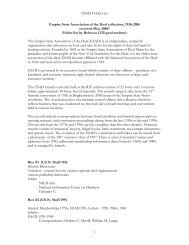

![A Conversation with Danny Glover & Joslyn Barnes [PDF]](https://img.yumpu.com/17810254/1/190x245/a-conversation-with-danny-glover-joslyn-barnes-pdf.jpg?quality=85)

